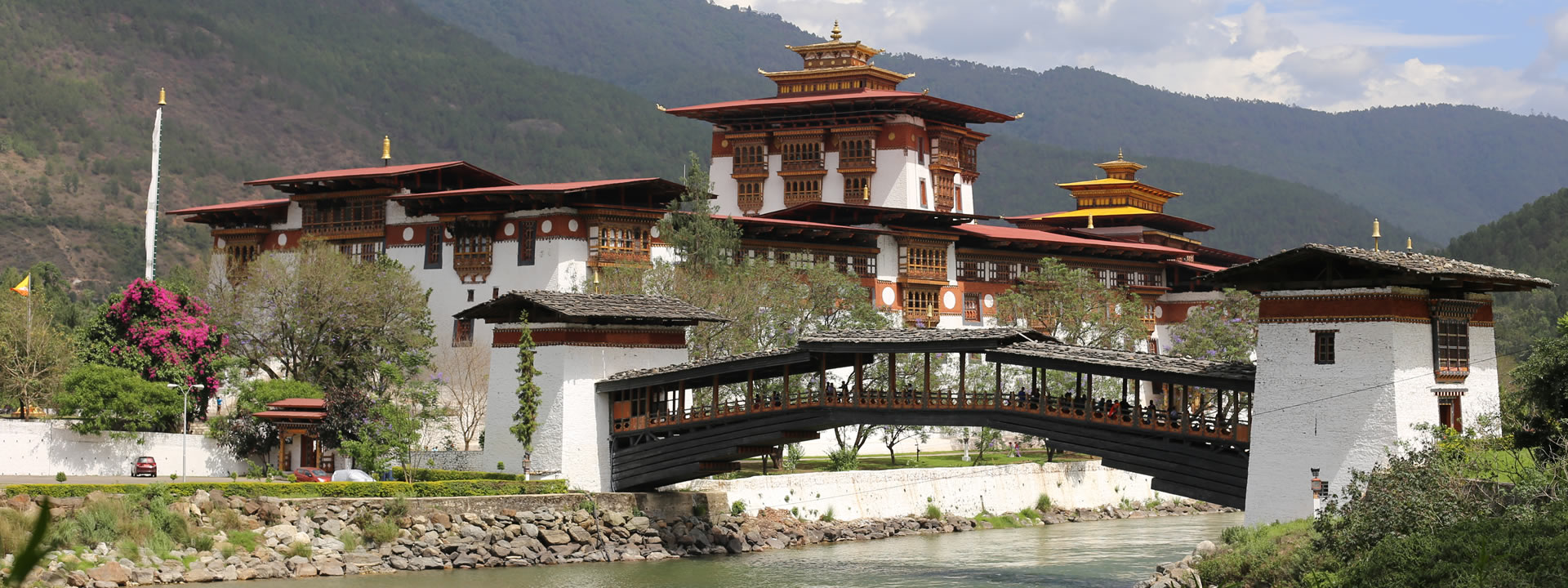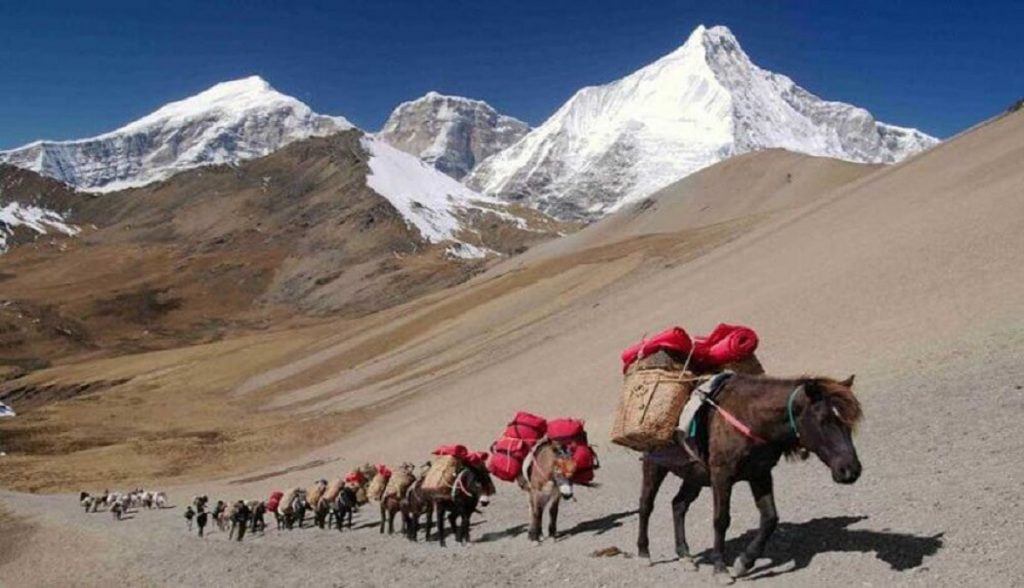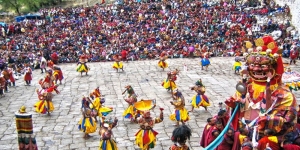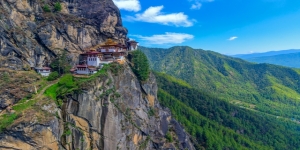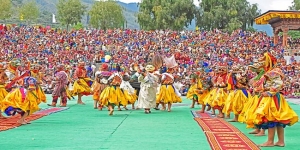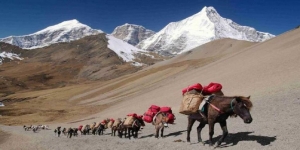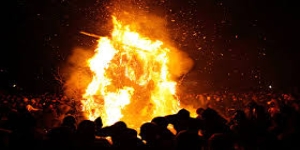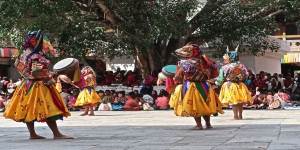This is 12 days Bhutan tour package combined with 6 days Druk Path Trek in Paro to Thimphu, the trek is the most popular trek in the country as it passes through a gorgeous natural landscape of blue pine forests, high ridges and pristine lakes while at the same time offering the opportunity to visit some ancient lhakhangs, dzongs and villages. The Druk Path Trek is also a fairly easy hike to undertake as the distances between rest camps is fairly short. The trail takes you through forests of fir, blue pine and dwarf rhododendrons at altitudes ranging between 2400-4200 m. This trek also offers hikers stunning views of Mt. Gangkar Puensum, the highest unscaled peak in the world. Book Druk Path Trek Thimphu with Heavenly Bhutan. Druk Path Trek Thimphu. 6 Days Trek in Paro. 6 Days Druk Path Trek.
Day 01: Arrival in Paro to Thimphu (1.5 Hr)
Fly on the wings of the Dragon to Bhutan, on arrival in Paro International Airport, complete the immigration formalities and exit through only one arrival gate where HBT dedicated team who will be holding placard, no one will be missed. We welcome with khaddar and proceed to Thimphu which will take about an hour and half. The route will follow Paro River until Chuzom from where we will bend towards Thimphu river taking us to the heart of capital city Thimphu. The entire stretch of drives is very scenic and picturesque as we pass by some of the beautiful villages of Bondey, Shaba, Isuna etc until we enter welcome gate in Thimphu. Visit the weekend market (Thu-Sun): An interesting well organized permanent set of stalls built for vegetable vendors across the country. It’s open from Wednesday to Monday and closed on Tuesdays. One can find wide range of local vegetables and fruits. Other side of the river is place for indigenous goods and handicrafts section, where locally produced goods, including religious objects, cloth, baskets and hats etc from various minority groups are sold here. These shops are open from Friday to Sunday only. In the evening we will explore the city by walk: If time permits, walking through the city gives you immense joys and understanding of modern city. Good option for imported garments and local souvenir, beside unique local handicrafts. Thimphu offers mixed style of personalities. Take the street walk in Thimphu- only city in the world without traffic lights. Visit Tashichho Dzong: Houses the throne room of His Majesty the King of Bhutan and government secretariat buildings, beautiful arts and crafts, built in 17th century. Visitors are open for an hour in the evening and closed during official meeting or gathering. Overnight in Thimphu, altitude 2400m
Day 02: Thimphu Sightseeing
Thimphu- This bustling little city is the main centre of commerce, religion and government in the country. Thimphu is the most modern city with an abundance of restaurants, internet cafes, nightclubs and shopping centers. However it still retains its cultural identity and values amidst the signs of modernization, often referred as world only city without traffic lights. Cheri Monastery: In 1627 the first Buddhist Monastic School for Bhutan was started by Shabdrung in Cheri, which to these days has become a Meditation center for higher level Buddhist studies. The Monastery buildings are old and still contains many sacred relic from past. Drive pass by Memorial Chorten: It is located close to the center of Thimphu city and is one of its most iconic monuments. Visitors will find elderly Bhutanese people circumambulating the Chorten throughout the day. The National Memorial Chorten was built in memory of Late Third King of Bhutan and dedicated to World Peace. Third King is regarded as father of modern Bhutan. Visit Buddha viewpoint: The Buddha Dordenma is located at a top of the hill in Kuensel Phodrang Nature Park and overlooks the southern entrance to Thimphu valley. Changangkha Lhakhang: Changangkha Lhakhang is located at the lower part of Motithang in upper Thimphu, on a small hill overlooking the Thimphu Town below. The main relic of Changangkha Lhakhang is the Chenrigzi in an 11 headed thousand arms manifestation. Visit textile museum: The National Textile Museum which opened in June 2001, is worth a leisurely visit to get to know the living national art of weaving. Changing exhibitions introduce the major weaving techniques, styles of local dress and textiles made by women and men. The small shop features work from the renowned weaving centers in Lhuntshe Dzongkhag, in north-eastern Bhutan. Each item is leveled with the name of the weaver and price. The textile museum’s exhibition are centered around six major themes – warp pattern weaves, weft pattern weaves, role of textiles in religion, achievements in textile arts, textiles from indigenous fibres and the royal collection. Overnight in Thimphu
Day 03: Thimphu to Punakha (2.5 hrs)
Start the most scenic drive to Punakha from Thimphu over dochula pass which takes about two hours. After the break at Dochula, the road descends into Wangdue and Punakha taking us to one of the warmest places of Bhutan. Dochula pass 3150m: The pass is at a popular location as it offers a stunning 180 degree panoramic view of the Great Himalayan mountain ranges. The view is especially scenic and very clear on winter days with snowcapped mountains forming a majestic backdrop to the tranquility of the 108 chortens gracing the mountain pass. Visit Lamperi Botanical Garden: The park has many varieties of plants, herbs, birds and animals. If you visit between April and June, you can find about 38 out of Bhutan’s 46 species of rhododendrons and spot some of the 220 species birds. This park is one of the must visit place for birds and nature lovers. You may enjoy the hot packed lunch here if you had planned picnic. Visit the most beautiful Punakha Dzong: Built in 1637 by Zhabdrung Ngawang Namgyal, the Dzong was named Druk Pungthang Dechen Phodrang (Palace of Great Happiness). Punakha is still the winter residence of Je-Khenpo religious head of Bhutan. King Jigme Dorji Wangchuck convened the first National Assembly here in 1952. This is one of the finest and must see Dzongs of Bhutan. The Dzong stands inbetween meeting point of two rivers, Phochu and Mochu making the most photogenic Dzongs of Bhutan. Enjoy the walks on the suspension bridge: Punakha suspension bridge is considered one of the longest of its kind in Bhutan. The bridge connects the dzong with the villages Shengana, Samdingkha and Wangkha on the other bank of the Po Chhu river. In these small villages, locals sell their wares in tiny, traditional shops. Visitors can stop here for a quick and authentic view of true Bhutan. In order to access the suspension bridge from the dzong, one must walk past the King’s palace and the cremation ground. Join the nuns for evening prayer at Sangchen Dorji Lhendrup nunnery: Sangchen Dorji Lhendrub Choling is located above Wolakha on the way to Drolay Goemba which serves as a Shedra (Buddhist College) and meditation center scatter the grassy site, home to a small and friendly community of nuns. Overnight in Punakha, altitude 1350m
Day 04: Punakha to Phobjikha (3 hrs)
The road to Phobjikha passes through old town of Wangdue taking us through the black mountain region into Gangtey. The drive also passes through some of the most beautiful forests, water fall, hills, river and villages and Pelela pass before stepping into Phobjikha. Enjoy the most scenic and adventurous drive today with HBT. Khamsum Yulley to Punakha Dzong old route hike: If you are up for a combination of visits to the beautiful Khamsum Chorten, the old hilltop temple Giligang and Punakha Dzong, with the opportunity to experience stunning views of the valleys on both the Mo Chhu and Po Chhu side, this is an enjoyable yet challenging hike. Gangtey Gompa: The temple built over hill top, headed by Gangtey Tulku the reincarnation of Pema Lingpa. Annual festival of Gangtey is performed in the temple courtyard every year. This is also the place for black necked crane’s festival held every year on 11-Nov, coinciding with His Majesty’s Fourth King’s Birthday. Crane center: This place is run by the Royal Society for Protection of Nature (RSPN) and has an observation room with high-power telescopes and good scope for spotting the famous Black Necked Cranes which migrates to the region during winter. It also displays information about the history of the region. Farmhouse visit with dinner with locals: This experience is a particularly fun and spontaneous way to connect with the local community and learn about Bhutanese culture and way of living. Overnight in Phobjikha, altitude 2900m
Day 05: Phobjikha to Thimphu (5 hrs)
We will retrace the journey crossing over Dochula and further to Thimphu. The entire stretch of drive will refresh your mind and give you second chance to enjoy the great snowcapped mountain views of the Himalayas from Dochula. Gangtey Nature Trail: It is a short and relatively easy trek with several beautiful villages and monasteries en route. It offers beautiful views of the country with mostly gentle, forested slopes. The best time for this trek is between September-May, walk not recommended on rainy days. Arts and Crafts Vocational School: Arts and Craft School is where student learn 13 different techniques to master in Bhutanese Arts. Some of the skills required eight years to graduate. You can see live carving, painting, sculpture etc. You are allowed to take the pictures/make video. Products made by students are on display at the showroom for sales as well. The school is closed in July and December to February, beside their exams and events. Folk Heritage Museum: This museum was established in 2001 and provides visitors with fascinating insights into the Bhutanese material culture and way of life, especially the life of Bhutanese in remote parts of Bhutan. Overnight in Thimphu, altitude 2400m
Day 06: Thimphu to Labana (Trek Starts), Distance: 12k, walking time: 6hrs, sleeping altitude: 3500m, Pass to cross: Pumo La, 4100m
The trek begins with decent climbing which continues for the whole day. Passing through the temple and meditation center complex of Phajoding. Further climbing of an hour will take you over Pumo La, the highest pass of this trek with a beautiful view of Thimphu valley overlooking. On a clear day, we can see the Gangkhar Puensum, which is one the highest peaks of Bhutan. Descending from the pass you will reach your first night camp.
Day 07: Labana to Jigmelangtsho, Distance: 15k, walking time: 7h, sleeping altitude: 3300m
The trail will take us through dwarf rhododendrons and junipers. We will also pass the lakes of Janatso and Simkotha. The view of the far ridge across the valley which you trekked will fill you with a sense of personal satisfaction and renew you with extra confidence in yourself. Our camp is at the lake of Jimilangtsho.
Day 08: Jigmelangtsho to Jangchulhakha, Distance: 13k, walking time: 6h, sleeping altitude: 3200m
The trek today starts off with a climb, leaving the quiet lake behind. Following the ridge, on a clear day, the Chomolhari mountain can be seen straight in front of your eyes. Rhododendrons and other high altitude shrubs decorate the rocky trail which climbs up and down. You may see yak herders around.
Day 09: Jangchulhakha to Jele Dzong, Distance: 10k, walking time: 4h, sleeping altitude: 3000m
Today’s trail looks like the setting of Stephen Spielberg’s Jurassic Park. With ancient firs wrapped in Spanish moss, a dinosaur or a Bhutanese Yeti might actually surprise you around the bend. Camp near Jela Dzong, a temple built as a war fortress in the olden days, overlooking the Paro valley below.
Day 10: Jele Dzong to Paro (Trek Ends). Distance: 10k, walking time: 4hr
Morning from the camp, you climb up for a short while and start descending through the pine forest. Crossing few farmhouses and through the dirt road, the Druk Path Trek ends at the historic Ta Dzong, the National Museum. The Druk path Trek ends at the historic Ta Dzong, the National Museum. Our transport will meet us there. Visit 17th century Paro Dzong: ‘Fortress on a Heap of Jewels’, is ranked one of the best Bhutanese architecture. The massive buttressed walls that tower over the town are visible throughout the valley, particularly when landing at Paro Airport. The Dzong also offers administrative seat of the district of Paro. The Dzong was built in 1644 under the order of Zhabdrung Ngawang Namgyal. Ta Dzong unique national museum: Perched above Paro Dzong it was watchtower built in 1649 to protect the undefended Paro Dzong located below, renovated in 1968 to house the National Museum. Today this museum houses the best collections of all time historical items making worth for a visit. Enjoy outdoor activities wearing Gho/Kira, play archery: Nicely made and well maintained activity place attached to whole sell Buddha statue store, offers wearing Bhutanese dress, playing archery and darts for guests visiting Bhutan. The center is maintained and operated by HBT herself and its free of cost for all HBT guests. Overnight in Paro, altitude 2200m
Day 11: Paro Sightseeing
This picturesque region in the kingdom is covered in fertile rice fields and has a beautiful, crystalline river meandering down the valley. Paro has more of historical sites, high-end tourist resort and many souvenir shops for shopping including world famous Takstang. Taktsang Monastery (Tiger Nest Temple): is Bhutan’s most iconic landmark and religious Buddhist site in the world. The name Taktsang translates to “The Tiger’s Nest”. The temple is one of the holiest sites in Bhutan which clings impossibly to a sheer cliff face 900 meters above the valley. Although good trekkers can make it to the top in two hours, most of the guests take whole day to complete the hike. Kyichu Lhakhang: Temple considered sacred Jewel of Bhutan was established by the Buddhist King Songstsen Gampo of Tibet to overcome the giant ogress that laid across Tibet and Himalayas preventing the spread of Buddhism. The king is believed to have built the temple at the left foot of the enormous ogress. Kichu Lhakhang was among 12 temples in Bhutan out of 108 temples said to have been constructed over single night. Kichu Lhakhang was initially small in size however later, the temple expanded both in grandeur and size to its form that we see today. Hot stone bath with dinner at the farmhouse: Hot stone bath is very unique which offers great medicinal values. In most cases, the bathtub is made of wood, placed on a ground level in quiet hut for the privacy. A couple can get into one bathtub to soak. Enjoy the great ancient techniques of curing body aches, joint pains and harness many other values. This is on additional cost check with guide/driver. Overnight in Paro
Day 12: End of the Tour
Departure from the Kingdom of Bhutan

